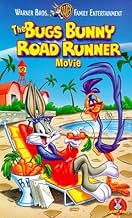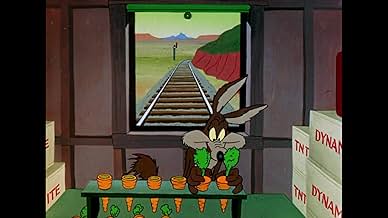CALIFICACIÓN DE IMDb
7.3/10
4.6 k
TU CALIFICACIÓN
Agrega una trama en tu idiomaBugs Bunny reflects on his past cartoon exploits.Bugs Bunny reflects on his past cartoon exploits.Bugs Bunny reflects on his past cartoon exploits.
- Premios
- 1 nominación en total
Mel Blanc
- Bugs Bunny
- (voz)
- …
Arthur Q. Bryan
- Elmer Fudd
- (material de archivo)
- (voz)
Paul Julian
- Road Runner
- (archivo de sonido)
Nicolai Shutorev
- Giovanni Jones
- (material de archivo)
- (doblaje en canto)
Joan Gerber
- Cavewoman
- (sin créditos)
Opiniones destacadas
In "The Great American Chase", Bugs Bunny traipses through his house and tells us the story of chases. To make his point, he shows us several classic cartoons (some starring him) dealing with situations involving hot pursuits. Well, not all of them have chases; some are there just for fun. Bugs remembers how Chuck Jones sent him into space, where he met Marvin the Martian; then how Daffy Duck and Porky Pig tried to colonize Planet X and had to contend with Marvin the Martian; how Daffy (as Robin Hood) had a very hard time recruiting Porky (as Friar Tuck); how Daffy's scenery frustratingly changed every few minutes; how he, Bugs, ended up in a bullfight; how he and Daffy dug into Ali Baba's cave; how he and Elmer Fudd acted out "The Ride of the Valkyries"; how Wile E. Coyote tried and failed to eat him; and finally, how Wile E. decided to try something a little more his size, by which we mean the Road Runner. The Wile E. Coyote/Road Runner chase is really the best part of the movie. Overall, it's a pretty neat compilation of classic cartoons, and I liked the scene where Bugs remembers his "fathers" (Mel Blanc, Chuck Jones, etc.).
This compilation of classic WB short cartoons is (expectedly) highly uneven, but generally enjoyable. Among the highlights: Bugs Bunny as a vengeful symphony conductor, he and Daffy Duck arguing about whether it's "duck season" or "rabbit season" (this sketch has a hilarious punchline), the surrealistic (and also somewhat sadistic!) "Duck Amuck", etc. The final "Road Runner" segment does go on a little too long. Overall, this is a nice way to spend 95 minutes mindlessly and painlessly, and also a good opportunity to see some of those shorts that you may have missed on TV. (**1/2)
Finally I got to see what I always wanted to see, the compilation of the best short films of Looney Tunes, the best jokes, best scenes, best characters, all the best. Highly recommend.
Bugs Bunny (Mel Blanc) looks back upon the history of comedy itself, his own career, and the careers of his various colleagues and co-stars as he takes us on a tour consisting of a showcase of classic cartoon shorts interwoven together through a loose narrative.
The Bugs Bunny/Road Runner Movie is a 1979 compilation film directed by Chuck Jones consisting of repackages of classic Looney Tunes shorts. Made for approximately $500,000, the film was a combination of original footage directed by Jones to serve as linking material between the shorts as a celebration of Bugs Bunny's then 40 year anniversary. While Warner Bros. Was initially uncertain whether or not the film would be released directly to television, the movie was given a theatrical release upon completion and while exact box office records are unavailable it did do reasonably well at Guild Theatre in New York City where it set a house record opening day. The movie in the era of streaming where the individual cartoons are widely available doesn't quite pack the punch it once did, but there is a sense of reverence and history that comes from the film that makes it worth viewing especially for Looney Tunes completionists.
The movie is framed with Bugs lounging around his luxurious mansion (a parody of Frank Lloyd Wright's "Fallingwater" house in Bear Run, Pennsylvania) wearing a smoking jacket as he takes us through the various paintings adorning the walls of his home which serve as springboards into the various cartoons interwoven into the plot. Following an amusing tongue in cheek explanation on the history of comedy that goes from the Universes origin of the big bang, to prehistoric times and eventually the silent film era, Bugs Bunny then goes through various points of history such as discussing his "many fathers" which was made by Jones as a way of rebuking Bob Clampett's claims of him having been solely responsible for Bugs Bunny's origin all the way through to Bugs Bunny regaling us with the greatest adventures with his co-stars. In a way the movie feels like you're catching up with an old friend who's telling you what you may have missed in the interim and it's a pleasant experience to say the least. The final stretch of the film is fifteen minutes of Wile E. Coyote/Road Runner shorts tied end to end from different cartoons and largely abandons the Bugs Bunny framing device as we just go from backfiring Road Runner trap to backfiring Road Runner trap and this is probably the weakest part of the film as the Wile E. Coyote cartoons while good do follow a predictable rhythm that works best in small doses and it becomes rather tiresome when it goes on for three times longer than it was intended to.
The Bugs Bunny/Road Runner Movie is an interesting time capsule of a film that works as a celebratory milestone of the endearing appeal of the Looney Tunes characters and a reflection upon their storied history. Following the advent of Home Media and especially streaming making individual shorts more widely available the point of this film and others of the same genre has largely been left extinct and by the cultural wayside, but there's an endearing charm to this first film.
The Bugs Bunny/Road Runner Movie is a 1979 compilation film directed by Chuck Jones consisting of repackages of classic Looney Tunes shorts. Made for approximately $500,000, the film was a combination of original footage directed by Jones to serve as linking material between the shorts as a celebration of Bugs Bunny's then 40 year anniversary. While Warner Bros. Was initially uncertain whether or not the film would be released directly to television, the movie was given a theatrical release upon completion and while exact box office records are unavailable it did do reasonably well at Guild Theatre in New York City where it set a house record opening day. The movie in the era of streaming where the individual cartoons are widely available doesn't quite pack the punch it once did, but there is a sense of reverence and history that comes from the film that makes it worth viewing especially for Looney Tunes completionists.
The movie is framed with Bugs lounging around his luxurious mansion (a parody of Frank Lloyd Wright's "Fallingwater" house in Bear Run, Pennsylvania) wearing a smoking jacket as he takes us through the various paintings adorning the walls of his home which serve as springboards into the various cartoons interwoven into the plot. Following an amusing tongue in cheek explanation on the history of comedy that goes from the Universes origin of the big bang, to prehistoric times and eventually the silent film era, Bugs Bunny then goes through various points of history such as discussing his "many fathers" which was made by Jones as a way of rebuking Bob Clampett's claims of him having been solely responsible for Bugs Bunny's origin all the way through to Bugs Bunny regaling us with the greatest adventures with his co-stars. In a way the movie feels like you're catching up with an old friend who's telling you what you may have missed in the interim and it's a pleasant experience to say the least. The final stretch of the film is fifteen minutes of Wile E. Coyote/Road Runner shorts tied end to end from different cartoons and largely abandons the Bugs Bunny framing device as we just go from backfiring Road Runner trap to backfiring Road Runner trap and this is probably the weakest part of the film as the Wile E. Coyote cartoons while good do follow a predictable rhythm that works best in small doses and it becomes rather tiresome when it goes on for three times longer than it was intended to.
The Bugs Bunny/Road Runner Movie is an interesting time capsule of a film that works as a celebratory milestone of the endearing appeal of the Looney Tunes characters and a reflection upon their storied history. Following the advent of Home Media and especially streaming making individual shorts more widely available the point of this film and others of the same genre has largely been left extinct and by the cultural wayside, but there's an endearing charm to this first film.
Skip the unctuous opening and fast-forward to the highlights: Bugs battling a bull; Daffy Duck battling an unseen animator; and the all-time great WHAT'S OPERA, DOC?, in which the usual Bugs-and-Elmer chase is done in best operatic style
¿Sabías que…?
- TriviaThe scene in which Bugs discusses his "several fathers" was written by Chuck Jones as a way to debunk fellow animation director Robert Clampett's claims throughout the 1970s that he alone created Bugs. Clampett's name is notably missing from Bugs's list. Also missing is Ben Hardaway, who created the earliest prototype of Bugs and was in fact the originator of the name "Bugs Bunny" (Bugs being Hardaway's own nickname), though in this case Jones later confirmed that the omission had simply been an oversight, and that he would have had no qualms about including Hardaway in the gallery.
- ErroresDuring the space text-crawl, a space appeared in the word "ago" (i.e. a long [...] time a go).
- Citas
Daffy Duck: [demanding the unseen animator to show himself] All Right! I've had enough of this. This is the final, final Straw-WHO'S RESPONSIBLE FOR THIS! I DEMAND THAT YOU SHOW YOURSELF! WHO ARE YOU? HUH?
[the animator draws a door in front of Daffy and shuts it, then he reveals himself as BUGS BUNNY!]
Bugs Bunny: Heh!Heh! Ain't I a stinker?
- Créditos curiososThe "That's All Folks" card keeps appearing at the beginning and end. In the beginning, after they show the Warner Communications logo, they show the traditional "That's All Folks" card that is usually shown at the end. Bugs Bunny appears in front of it and sniffs and gets rid of the background and sniffs again then he pushes the words "That's" and "All Folks" separately and down comes the word "NOT" in red capital letters underlined. Then it reads, "That's NOT All Folks!" Then Bugs pulls the traditional opening Warner Bros. logo shown at the beginning.
- Versiones alternativasLater cut to 78 minutes for Cable TV and 48 minutes for network TV.
- ConexionesEdited from El Canto del Conejo (1949)
Selecciones populares
Inicia sesión para calificar y agrega a la lista de videos para obtener recomendaciones personalizadas
Detalles
- Fecha de lanzamiento
- País de origen
- Idioma
- También se conoce como
- La película de Bugs Bunny y el Correcaminos
- Productoras
- Ver más créditos de la compañía en IMDbPro
Contribuir a esta página
Sugiere una edición o agrega el contenido que falta

Principales brechas de datos
By what name was El Show de Bugs Bunny y sus Amigos (1979) officially released in India in English?
Responda






















